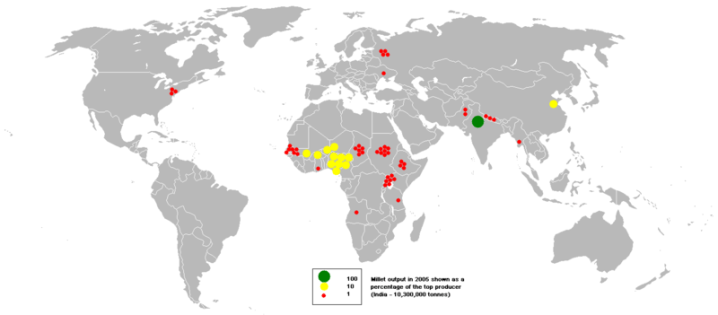
After returning from vacation back in August, I discovered a small plant growing in the small flower bed next to my driveway. Nestled among the dead rose bushes, the stalk-like plant had leaves that looked like corn. Thinking it was another weed, I ignored it for a couple weeks during which time it grew some two feet. It sprouted seeds at the top and spread out into several shoots – in all about three feet wide. If there ever was a case for Wikipedia, this was it. I immediately suspected that the plant might be millet, although I had never seen a millet plant before. My suspicions were correct. Wikipedia contained more about millet than most people would ever want to know. It appears that the variety growing in my flower bed is Indian Barnyard Millet (or echinochloa frumentacea for those who might care about these things).
I learned that Millet is a major cereal grain grown in much of the world, especially in India and east Asia. I also learned that millet is sometimes used as an “edible ornamental” among gardeners. Wikipedia provides the following graphic showing the distribution of the major millet growing regions in the world.

But the question remained. How did the millet get planted among my dead roses? As it turns out, my next door neighbor, Dick, has a bird feeder in which he puts a mix of seeds that contain millet. Because the feeder is behind his house and I found the millet plant on the front of my house, I don’t think the wind blew the millet to the flower bed. My hypothesis is that a bird somehow carried at least one millet seed from the bird feeder to its final destination. (I believe Dick when he says that he didn’t do it.) I would rather not speculate about the exact delivery method the bird employed to plant the seed.
For those who might be interested in cultivating millet yourselves, let me assure you that the millet plant requires no attention whatsoever. It grows like a weed, but looks like an upscale decorative plant. I’m not sure where to buy millet seed, but bird seed is available everywhere. Now that I have an ample supply of millet seed, I am considering full-time cultivation. Next year at this time my backyard may be known as the millet capital of Wisconsin.


Very cool Cousin Charlie. It is a nice looking plant!
LikeLike
thank you sooo much for solving my mystery. I have many of these plants growing in the mulched areas of my yard and knew they were not corn. Also , I have 5 bird feeders in my yard so mystery definately solved.
LikeLike
Yes, I think the bird feeders are the key. This past summer, however, I didn’t have any millet. I’m guessing my neighbor changed the brand of his bird feed.
LikeLike
Thanks for Solving this Mystery plant that has been growing in my Garden for two years. It was in the Birdfeed.
LikeLike
I’m thinking that this spring I’ll try planting some in my yard, instead of relying on the birds.
LikeLike
Although Florida is not on the map for millet, it looks a lot like a plant used here often in landscaping.
LikeLike
The local botanical gardens have planted a bit of it. They list it as an “edible ornamental.”
LikeLike
Hi,
You also solved my mystery plant.. TY I thought it might be Millet because of my bird feeders as well..My question
is, can i eat this millet and how do you prepare it. Does it have to dry out, to obtain the seeds. Any help would be appreciated.
Thanks, Happy Gardening
Linda
LikeLike
Hi Linda. I don’t know about preparing the Miller for food. I’m assuming it can be done without to much trouble. I was in China and there they are lots of it. It was served as a gruel at breakfast. I tried harvesting the seeds and I planted them the following spring, but they never germinated. So, I’m not too much help in this area.
Charles
LikeLike